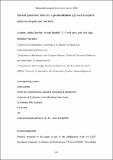Files in this item
Stacked space-time densities : a geovisualisation approach to explore dynamics of space use over time
Item metadata
| dc.contributor.author | Demsar, Urska | |
| dc.contributor.author | Buchin, Kevin | |
| dc.contributor.author | van Loon, Emiel E. | |
| dc.contributor.author | Shamoun-Baranes, Judy | |
| dc.date.accessioned | 2015-10-30T15:40:03Z | |
| dc.date.available | 2015-10-30T15:40:03Z | |
| dc.date.issued | 2015-01 | |
| dc.identifier | 108603444 | |
| dc.identifier | 98bb426e-e84a-40c4-9029-50bdf3e1973b | |
| dc.identifier | 84920709126 | |
| dc.identifier | 000347691300004 | |
| dc.identifier.citation | Demsar , U , Buchin , K , van Loon , E E & Shamoun-Baranes , J 2015 , ' Stacked space-time densities : a geovisualisation approach to explore dynamics of space use over time ' , GeoInformatica , vol. 19 , no. 1 , pp. 85-115 . https://doi.org/10.1007/s10707-014-0207-5 | en |
| dc.identifier.issn | 1384-6175 | |
| dc.identifier.other | ORCID: /0000-0001-7791-2807/work/48516858 | |
| dc.identifier.uri | https://hdl.handle.net/10023/7717 | |
| dc.description | Research presented in this paper is part of the collaboration under the COST (European Cooperation in Science and Technology) ICT Action IC0903, “Knowledge Discovery from Moving Objects (MOVE)” and facilitated by the Lorentz Center workshop on “Analysis and visualization of moving objects”(http://www.lorentzcenter.nl/lc/web/2011/453/info.php3?wsid=453) | en |
| dc.description.abstract | Recent developments and ubiquitous use of global positioning devices have revolutionised movement ecology. Scientists are able to collect increasingly larger movement datasets at increasingly smaller spatial and temporal resolutions. These data consist of trajectories in space and time, represented as time series of measured locations for each tagged animal. Such data are analysed and visualised using methods for estimation of home range or utilisation distribution, which are often based on 2D kernel density in geographic space. These methods have been developed for much sparser and smaller datasets obtained through very high frequency (VHF) radio telemetry. They focus on the spatial distribution of measurement locations and ignore time and sequentiality of measurements. We present an alternative geovisualisation method for spatio-temporal aggregation of trajectories of tagged animals: stacked space-time densities. The method was developed to visually portray temporal changes in animal use of space using a volumetric display in a space-time cube. We describe the algorithm for calculation of stacked densities using four different decay functions, normally used in space use studies: linear decay, bisquare decay, Gaussian decay and Brownian decay. We present a case study, where we visualise trajectories of lesser black backed gulls, collected over 30 days. We demonstrate how the method can be used to evaluate temporal site fidelity of each bird through identification of two different temporal movement patterns in the stacked density volume: spatio-temporal hot spots and spatial-only hot spots. | |
| dc.format.extent | 1125568 | |
| dc.language.iso | eng | |
| dc.relation.ispartof | GeoInformatica | en |
| dc.subject | Animal Movement | en |
| dc.subject | Space-time Density | en |
| dc.subject | Space-time Cube | en |
| dc.subject | Visual data exploration | en |
| dc.subject | Home range estimation | en |
| dc.subject | Utilisation distribution | en |
| dc.subject | G Geography (General) | en |
| dc.subject | QA75 Electronic computers. Computer science | en |
| dc.subject | NDAS | en |
| dc.subject | BDC | en |
| dc.subject | R2C | en |
| dc.subject.lcc | G1 | en |
| dc.subject.lcc | QA75 | en |
| dc.title | Stacked space-time densities : a geovisualisation approach to explore dynamics of space use over time | en |
| dc.type | Journal article | en |
| dc.contributor.institution | University of St Andrews. Bell-Edwards Geographic Data Institute | en |
| dc.contributor.institution | University of St Andrews. School of Geography & Sustainable Development | en |
| dc.contributor.institution | University of St Andrews. Centre for Geoinformatics | en |
| dc.contributor.institution | University of St Andrews. Geography & Sustainable Development | en |
| dc.identifier.doi | https://doi.org/10.1007/s10707-014-0207-5 | |
| dc.description.status | Peer reviewed | en |
| dc.date.embargoedUntil | 2015-04-03 |
This item appears in the following Collection(s)
Items in the St Andrews Research Repository are protected by copyright, with all rights reserved, unless otherwise indicated.

